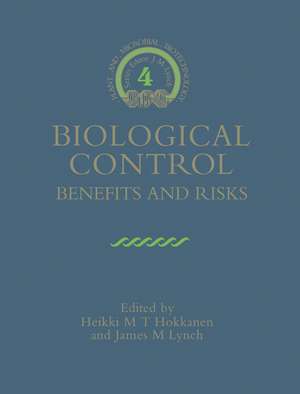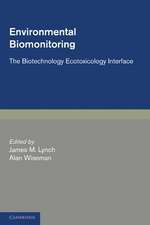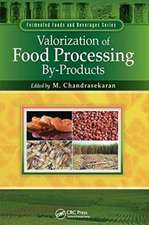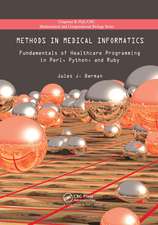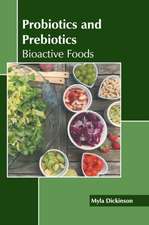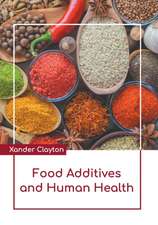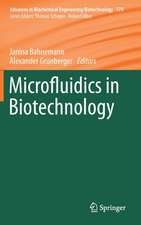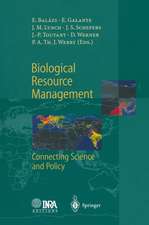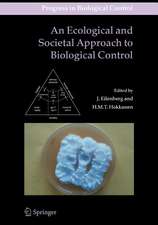Biological Control: Benefits and Risks: Biotechnology Research, cartea 4
Editat de Heikki M. T. Hokkanen, James M. Lynchen Limba Engleză Paperback – 29 oct 2003
Preț: 450.22 lei
Nou
Puncte Express: 675
Preț estimativ în valută:
86.15€ • 90.19$ • 71.28£
86.15€ • 90.19$ • 71.28£
Carte tipărită la comandă
Livrare economică 05-19 aprilie
Preluare comenzi: 021 569.72.76
Specificații
ISBN-13: 9780521544054
ISBN-10: 052154405X
Pagini: 328
Ilustrații: 43 b/w illus. 27 tables
Dimensiuni: 190 x 247 x 19 mm
Greutate: 0.59 kg
Ediția:Revised
Editura: Cambridge University Press
Colecția Cambridge University Press
Seria Biotechnology Research
Locul publicării:Cambridge, United Kingdom
ISBN-10: 052154405X
Pagini: 328
Ilustrații: 43 b/w illus. 27 tables
Dimensiuni: 190 x 247 x 19 mm
Greutate: 0.59 kg
Ediția:Revised
Editura: Cambridge University Press
Colecția Cambridge University Press
Seria Biotechnology Research
Locul publicării:Cambridge, United Kingdom
Cuprins
Overview of benefits and risks of biological control introductions; Part I. Biological Invasions: 1. Suppressiveness of soils to invading micro-organisms Claude Alabouvette and C. Steinberg; 2. Biotechnology: environmental impacts of introducing crops and biocontrol agents in North American agriculture David Pimentel; 3. Frequency and consequences of insect invasions Joop C. van Lenteren; 4. Integrated pest management (IPM) in fruit orchards Torgeir Edland; Part II. Classical Biocontrol: 5. Benefits and risks of classical biological control David J. Greathead; 6. Potential impacts on threatened and endangered insects species in the United States from introductions of parasitic hymenoptera for the control of insect pests Keith R. Hopper; 7. Lessons from post-release investigations in classical biological control: the case of Microctonus aethiopoides Loan (Hym., Braconidae) introduced into Australia and New Zealand for the biological control of Sitona discoideus gyllenhal (Col., Curculionidae Jean-Paul Aeschlimann; 8. Host specificity screening of insect biological weed control agents as part of an environmental risk assessment Bernd Blossey; Part III. Augmentative Control: 9. The use of exotic organisms as biopesticides: some issues Jeff Waage; 10. Use of Trichogramma in Maize - estimating environmental risks D. A. Andow, C. P. Lane and D. M. Olson; 11. Entomopathogenic nematodes in biological control: feasibility, perspectives and possible risks Ralf-Udo Ehlers and Arne Peters; 12. Pseudomonads as biocontrol agents of diseases caused by soil-borne pathogens Geneviève Défago and Christoph Keel; 13. Biological control of soil-borne pathogens of wheat: benefits, risks and current challenges David M. Weller, Linda S. Thomashow and R. James Cook; 14. Genetically engineered fluorescent pseudomonads for improved biocontrol of plant pathogens David N. Dowling, Bert Boesten, Daniel J. O'Sullivan, Peter Stephens, John Morris and Fergal O'Gara; 15. Biological control of foliar fungal diseases Nyckle J. Fokkema; 16. The use of fungi, particularly Trichoderma spp. and Gliocladium spp., to control root rot and damping-off diseases Dan Funck Jensen and Hanne Wolffhechel; 17. Bacillus thuringiensis in pest control Raymond J. C. Cannon; 18. Opportunities with baculoviruses Jürg Huber; Part IV. Use of Genetically-Modified Organisms: 19. Assessing the potential benefits and risks of introducing natural and genetically manipulated bacteria for the control of soil-borne root diseases Maarten H. Ryder and Raymond L. Correll; 20. Serodiagnostic methods for risk assessment of Pseudomonas cepacia as a biocontrol agent Kenichi Tsuchiya; 21. Benefits and risks of using genetically engineered baculoviruses as insecticides Norman E. Crook and Doreen Winstanley; 22. Mathematical modelling of gene exchange in soil James M. Lynch, M. J. Bazin and J. Choi; 23. Pest resistance to Bacillus thuringiensis: ecological crop assessment for Bt gene incorporation and strategies of management C. Howard Wearing and Heikki M. T. Hokkanen; 24. An international perspective for the release of genetically engineered organisms for biological control Max J. Whitten; Part V. Economics and Registration: 25. Development of the biocontrol fungus Gliocladium virens: risk assessment and approval for horticultural use Robert D. Lumsden and J. F. Walter; 26. Economics of classical biological control: a research perspective J. M. Cullen and Max J. Whitten; 27. Economics of biocontrol agents: an industrial view Timo Törmälä; 28. Registration requirements of biological control agents in Germany and in the European Union Fred A. J. Klingauf; Index.
Recenzii
'… this book is a must for anyone working in the field of biological control and involved in the discussions on achieving a larger impact with biological control methods in the world-wide control of pests and diseases.' Peter H. Smits, Entomologia Experimentalis et Applicata
'… an excellent addition to the Plant and Microbial Biotechnology Research Series ...The coverage and balance of this book is commendable … a well-edited book and is highly recommended to students, teachers and researchers in the fields of biology, crop production, pest management and environmental studies.' J. L. Garraway, Biological Agriculture and Horticulture
'This comprehensive hard cover book was prepared to cover fundamental as well as applied aspects of biological control. This goal was achieved … it is a very useful text for students of biological control.' Harry A. J. Hoitink, Journal of Environmental Quality
' … the editors have done a commendable job in drawing together a broader range of topics than are commonly found in texts on biological control … this book certainly deserves a place on bookshelves of scientists involved in biological control research.' Nick Mills, Bulletin of Entomological Research
'… there is much of relevance for plant pathologists in this book, and, perhaps, a glimpse into the future …'. H. C. Evans, Plant Pathology
'… an excellent addition to the Plant and Microbial Biotechnology Research Series ...The coverage and balance of this book is commendable … a well-edited book and is highly recommended to students, teachers and researchers in the fields of biology, crop production, pest management and environmental studies.' J. L. Garraway, Biological Agriculture and Horticulture
'This comprehensive hard cover book was prepared to cover fundamental as well as applied aspects of biological control. This goal was achieved … it is a very useful text for students of biological control.' Harry A. J. Hoitink, Journal of Environmental Quality
' … the editors have done a commendable job in drawing together a broader range of topics than are commonly found in texts on biological control … this book certainly deserves a place on bookshelves of scientists involved in biological control research.' Nick Mills, Bulletin of Entomological Research
'… there is much of relevance for plant pathologists in this book, and, perhaps, a glimpse into the future …'. H. C. Evans, Plant Pathology
Descriere
This book discusses and debates the benefits and risks associated with biological control.
